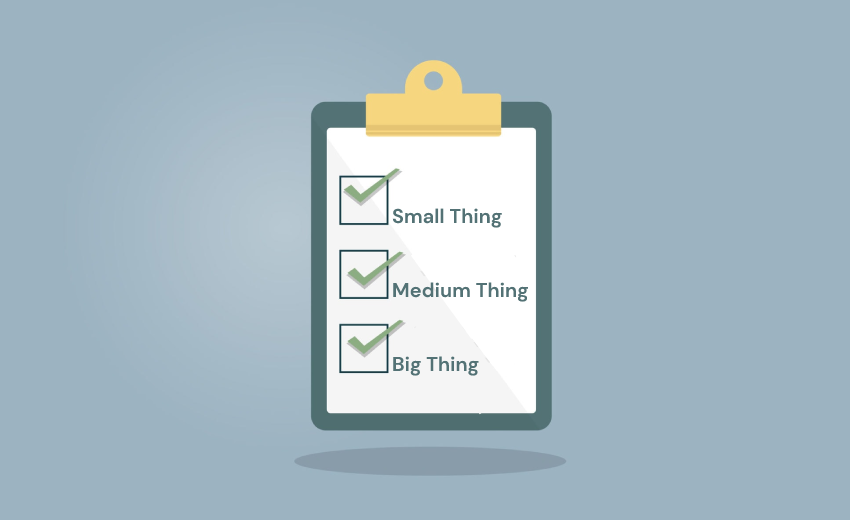
What is 1-3-5 Rule and how can it boost your productivity
Lots of work to do? Do you make an overflowing to-do list to get all the work done but instead feel overwhelmed seeing it? We feel you. Managing time and productivity simultaneously can be very overwhelming. When you don’t have proper methods to complete your to-do list, most probably you will fail to get things done.
The pressure to accomplish numerous tasks can lead to stress, anxiety, and a sense of being constantly behind schedule. This feeling can often hinder productivity rather than enhance it.
This is where the 1-3-5 rule comes into effect. This can help amplify your workplace productivity significantly. This method encourages individuals to focus on accomplishing a limited number of tasks each day. These tasks are separated on the basis of how large and difficult it is, thereby prioritizing what matters the most and avoiding the trap of trying to tackle everything at once.
Sounds a little simpler now? Well, keep reading. Further in the blog, we will discuss how the 1-3-5 rule works, its benefits, how time tracking software works in accordance with this rule and understand how to implement it.
What is the 1-3-5 Rule?
The 1-3-5 Rule is a structured technique by which you can categorize your tasks into a to-do list that is proven to increase productivity. This rule asks you to accomplish 1 big mission, 3 medium tasks, and 5 small things. Coupling this productivity rule with your to-do list can give a boost to your productivity.
How does the 1-3-5 rule work?

Breaking Down the 1-3-5 Rule
- Main Task:
The most important thing you need to do.
- Medium Tasks:
Important things that need focus but aren’t as big as the main task.
- Small Tasks:
Quick and easy things to keep you going without feeling overwhelmed.

How to choose the main task?
It’s the one task that, when completed, will have the most significant impact on your goals or objectives. You can identify this task based on its importance, urgency, or alignment with your long-term priorities. Focus on completing this major task first and set the tone for a successful and fulfilling day.
It is easier to find undisturbed short intervals of time to do small tasks in a day than to find long hours of uninterrupted hours to do a bigger task.
This is what the 1-3-5 rule takes into consideration.
The rule emphasizes the importance of getting the most difficult and important task to get done first.
It also recognizes that if tasks are simpler, we need to do more of them to be productive. If the tasks are simple, you can definitely make time to do more of them in a day. If the task is complicated, is of high priority and takes time, you can plan your day accordingly.
So the most important task is to list down all the tasks based on their complexity and priority. The rule suggests we analyze the tasks and choose 1 big mission, 3 medium tasks, and 5 small things.
Read More : How Many Working Days Are in a Month?
Why do we fail to achieve our to-do list?
There are just too many things to be done every day to survive our ruthless competitive world. Most of our plans end up being mere fantasies. This is because we plan our day with no strategy or understanding of our capabilities and schedules. When we get bombarded with too many meetings, tasks, unexpected chit-chats, and breaks, we lose track of our plans.
Each day comes with unexpected distractions that ruin our plans. It could be your wrecked heels, that bus that came late, or your inability to turn back a colleague that doesn’t stop talking. Every 5 minutes of distraction has the strength to bring your plans out of shape.The 1-3-5 Rule reorients our tasks to a list that is achievable in a day giving respect to our schedules and unexpected time lags.
Benefits of following a 1-3-5 to-do list for enhancing productivity
The 1-3-5 rule helps you from feeling overwhelmed and left behind in your everyday to-do lists. Following listed are some of the best benefits of following the 1-3-5 to-do list.
Increases your productivity
The first thing to say about what this rule can do to you is – it lifts up your productivity and helps to get more things done


Helps to prioritize your work
Without a good understanding of what your priorities are, you are mostly lost. When we incorporate a productivity-enhancing framework like the 1-3-5 rule into our to-do list, we give more thought to what measures of priority each task deserves.
Helps to build a more practical to-do list
Ninety percent of respondents in a LinkedIn poll claimed that they don’t get to fulfill their everyday to-do list. This brings us to the conclusion that most days are not as predictable as we think. However, the 1-3-5 rule gives a flexible to-do list that gets more things done

Helps to focus on tasks that actually matter
1-3-5 rule helps to focus on tasks that actually matter when we split less time for small, miscellaneous, and less priority tasks
How to Implement the 1-3-5 Rule?
1. List all your tasks for the day, week, or project
Start by listing out all the tasks you need to accomplish for the day, week, or project. Don’t just keep them in your head. Write them down in one place so you can see everything at a glance. This will help you look at the tasks and analyze better.
When compiling your task list, allow your thoughts to freely flow. Embrace the process of transferring everything from your mind onto paper without judgment. You can organize and prioritize the tasks later on.
Additional Tips to Implement this Step:
- Use a digital task management tool or a traditional pen and paper to jot down your tasks.
- Break down larger projects into smaller, actionable tasks to make them more manageable.
- Set realistic deadlines for each task to help prioritize and plan your workload effectively.
Keep separate lists for this week and next week
Tasks for This Week: Maintain a list of tasks that need to be completed within the current week. These are the priorities that require immediate attention and action. Keep this list handy, keep room for updates and changes and regularly update it as you progress through the week.
Tasks for Next Week: Create a separate list for tasks that you plan to tackle in the upcoming week. This is to be done in order to not forget or overlook the tasks coming up while staying focused on the current week’s task. Whenever a new task or project arises, jot it down immediately on this “Next Week” list.
Additional Tips to Implement this Step:
- Designate specific times during the week to review and update both lists. This could be at the beginning or end of each day, or as part of your weekly planning session.
- Prioritize tasks on your “Next Week” list based on their importance and urgency. Consider whether they need to be completed early in the week or can wait until later.
- Use a digital task management tool or time tracking software with separate lists or categories for this week and next week to keep your tasks organized and easily accessible.
- Be flexible and willing to adjust your plans as needed. If a new task becomes more urgent or important, you may need to move it from your “Next Week” list to your current week’s list.
- Always keep your list accessible. Make room for edits and update it regularly.
Brain Dumping at the Start of Each Week
Clear Out Your Head: Start your week by doing a brain dump of all your tasks. Write down everything that’s on your mind, from work assignments to personal errands. This exercise helps clear mental clutter and provides a sense of relief by getting everything out of your head and onto paper.
Focus on One Task at a Time: With your tasks written down, you can now focus on one specific task at a time without feeling overwhelmed by trying to remember everything. This allows for better concentration and productivity as you tackle each task individually.
Additional Tips to Implement this Step:
- Schedule dedicated time for your weekly brain dump at the beginning of each week. Make it a habit to review and update your task lists regularly.
- Keep a notebook or digital app handy for quick and easy note-taking whenever a new task or idea pops into your head throughout the week.
- Break down large tasks into smaller, actionable steps to make them more manageable and less overwhelming.
2. Categorizing Tasks by Importance and Effort
Major Tasks: Identify tasks that are high in importance and require significant effort to complete. These are the tasks that have a direct impact on your goals or objectives and may take up a substantial portion of your time and energy.
Medium Tasks: Recognize tasks that are important but may not be as critical or time-consuming as major tasks. These tasks still require dedicated focus and effort to complete effectively but may not have the same level of impact on your overall objectives.
Small Tasks: List tasks that are quick and easy to accomplish, requiring minimal effort and time investment. While these tasks may not be as significant as major or medium tasks, they still contribute to your overall productivity and progress.
Additional Tips to Implement this Step:
- Don’t spend too much time agonizing over the perfect categorization of tasks. Trust your instincts and assign each task to a category based on your initial assessment.
- Pay attention to how long similar tasks or projects have taken you in the past. Use this information to estimate the effort required for new tasks and adjust your categorization accordingly.
- Review your list of small tasks and consider whether they truly need to be done by you. If possible, delegate these tasks to others or eliminate them altogether to free up time for more important activities.
3. Create Your 1-3-5 List
Select one major task that aligns with your overarching goals or objectives for the day. Then, identify three medium tasks that require dedicated focus but are not as impactful as the major task. Finally, pick five small tasks that can be completed quickly to maintain momentum and productivity.
For example, if your goal is to launch a new product, your major task for the day might be to finalize the product design or create a marketing plan to promote its release.
Additional Tips to Implement this Step:
- Explore apps specifically designed for creating 1-3-5 lists. These apps provide a fresh page daily, making it easy to jot down your tasks for the day and stay organized.
- If you already use a to-do list app, customize it to accommodate the 1-3-5 rule. Create daily lists or groups for your big, medium, and small tasks, ensuring a clear organization of your tasks.
- Use a new page of your notebook or planner each day to create your 1-3-5 list. It doesn’t have to be elaborate; the key is to commit to getting your tasks on paper and focusing on them for the day.
4. Start with the Biggest Task First
Begin with the Major Task: Start your day by tackling the major task you identified. This task is significant and has a direct impact on your overarching goals or objectives. By prioritizing it first, you ensure that you’re dedicating your focus and energy to the most important aspect of your day.
Additional Tips to Implement this Step:
- Avoid Distractions: Consider skipping early morning office chit chat or other non-essential activities that could divert your attention away from your major task. Focus on getting a head start and maintaining momentum.
- Break it Down: If your major task is particularly large or complex, break it down into smaller, manageable tasks. This can help prevent overwhelm and make it easier to make progress steadily throughout the day.
- Take Strategic Breaks: While it’s recommended to work on your major task continuously, it’s also important to listen to your body and mind. If you need a break, consider working on a small task as a quick interlude to recharge before returning to your major task. Just ensure that these breaks don’t derail your progress or lead to procrastination.
5. Use the Pomodoro Method
The Pomodoro Technique is a time management method that breaks work into intervals, traditionally 25 minutes in length, separated by short breaks. It’s a highly effective way to maintain focus and productivity while avoiding burnout.
Additional Tips to Implement this Step:
- Download Pomodoro Apps: There are many free Pomodoro apps available for download on your computer or mobile device. These apps are often pre-programmed to help you track your work time with Pomodoros and provide recommended break durations.
- Customize to Your Work Style: Customize your Pomodoro app to suit your preferences and work style. If you find that 25 minutes of focused work is too short or too long for you, adjust the timer accordingly. You can also choose to skip short breaks and only take longer breaks if it better aligns with your workflow.
- Track Your Progress: Pay attention to how many Pomodoros it typically takes for you to complete a task. This information can help you better estimate the time and effort required for similar tasks in the future. By understanding your productivity patterns, you can plan your work sessions more effectively and improve your time management skills.
1-3-5 Rule App
If you want to digitalize your to-do list and find its management at your fingertips, 1-3-5 rule apps can help you. Some of the best software or apps to implement the 1-3-5 rule are:
Benefits of following a 1-3-5 to-do list for enhancing productivity
The 1-3-5 rule helps you from feeling overwhelmed and left behind in your everyday to-do lists.
Benefits of the 1-3-5 Rule
- Increased Productivity:
By completing the major task identified for the day, you ensure progress on your most important work. This focused approach to task prioritization helps you allocate your time and energy more effectively, leading to greater productivity and accomplishment.
- Improved Focus:
Categorizing tasks into major, medium, and small helps minimize distractions and keep you on track. By knowing exactly what needs to be done and in what order, you can maintain a clear focus on your priorities and avoid getting sidetracked by less important tasks or interruptions.
- Sense of Accomplishment:
Completing small and medium tasks throughout the day provides a sense of progress and motivation. Each task you check off your list contributes to your overall productivity and moves you closer to your goals, giving you a tangible sense of accomplishment and satisfaction.
- Reduced Overwhelm:
Having a manageable list of tasks to focus on prevents feeling overloaded and overwhelmed. By breaking down your workload into smaller, more manageable chunks, you can approach each task with confidence and clarity, knowing that you have a plan in place to tackle them effectively.
Usage of time tracking software to enhance 1-3-5
Traditional timesheets are now outdated. There’s a huge difference between traditional time sheets and time tracking software. Using time tracking software can greatly enhance the effectiveness of the 1-3-5 rule by providing valuable insights into how you spend your time and helping you optimize your productivity. Since everything is being tracked, it also helps in employee accountability.
Here are some points to consider:
- Track Task Duration:
Time tracking software allows you to monitor how much time you spend on each task, including major, medium, and small tasks. This data helps you understand your productivity patterns and identify areas where you may need to improve efficiency. By utilizing time tracking software effectively, you can optimize your productivity. Explore how to enhance your productivity with time tracking software.
- Evaluate Task Prioritization:
By tracking the time spent on different tasks, you can evaluate whether your prioritization aligns with the actual time investment required for each task. This information allows you to adjust your task prioritization accordingly and ensure that you’re focusing on the most impactful activities.
- Identify Time Wasters:
Time tracking software can reveal time-wasting activities or distractions that may be hindering your productivity. By identifying these inefficiencies, you can take steps to minimize or eliminate them, allowing you to make better use of your time.
- Optimize Time Allocation:
Analyzing time tracking data enables you to optimize your time allocation for different types of tasks. For example, if you consistently underestimate the time required for major tasks, you can adjust your scheduling to allow for more realistic timeframes.
- Set Time-Based Goals:
Time tracking software helps you set and track time-based goals for completing tasks. By setting deadlines or time limits for each task, you can create a sense of urgency and accountability, motivating you to stay focused and productive.
- Improve Time Management Skills:
Regularly reviewing time tracking data provides valuable insights into your time management habits and allows you to identify areas for improvement. Over time, you can develop better time management skills and strategies to optimize your productivity.
- Enhance Accountability:
Time tracking software can enhance accountability by providing a clear record of your time spent on tasks. This accountability can help you stay committed to your goals and maintain discipline in managing your time effectively.
Managing a long list of tasks can be overwhelming and may lead to decreased productivity and increased stress. The 1-3-5 rule offers a structured approach to task management that prioritizes focus, efficiency, and effectiveness.
The 1-3-5 rule provides a practical framework for organizing tasks, prioritizing workload, and maximizing productivity.
Time tracking software helps the most when it comes to trying out the 1-3-5 rule. You can also manage your project backlog with time tracking software.
By following this rule and incorporating additional productivity techniques, you can experience increased focus, and a greater sense of accomplishment in daily work and personal life.
No more struggling with completing your tasks! Keep your anxiety in check with the 1-3-5 rule and increase your productivity.
Want to try our Time Tracking Software?
Try Desklog for free!

Final Thoughts
Implementing the 1-3-5 Rule in your everyday life will boost your productivity. Coupling this productivity technique with other equally benefiting techniques can further give an upliftment to your productivity. According to Gallup, 85 % of employees feel disengaged at work and this causes productivity to lose costing $7 Trillion a year. Do not organize things in your brain. Give it the liberty to be out there in the paper. Releasing your to-do list from your head and burdening its organization on a paper will itself feel comforting for your head from being bombarded with thoughts.



